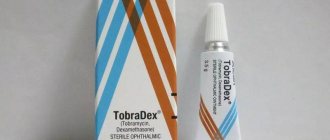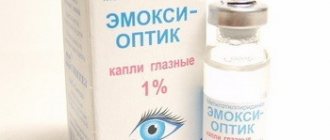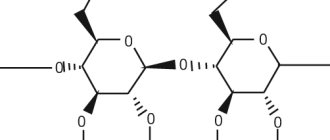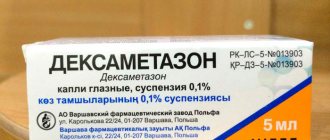An allergic reaction to external irritants, such as dust, animal hair, pollen, household chemicals and others provoke the development of conjunctivitis, redness, and itching in the eyes. It is in such situations that Cromohexal drops are prescribed, which can be used in a course to treat allergic eye diseases or once after contact with an allergen.
Contraindications
A contraindication to the use of Cromohexal is individual hypersensitivity to cromoglycic acid or any other component of this drug.
It is not recommended to use Cromohexal in patients under four years of age.
Although there is no data on the negative effect of Cromohexal on the fetus during pregnancy, this drug, especially in the first trimester, must be taken with great caution. Since cromoglycic acid is excreted in small quantities in mother's milk, taking Cromohexal during breastfeeding is possible only if the benefit expected for the mother outweighs the likely risk for the child
Since cromoglycic acid is excreted in small quantities in mother's milk, taking Cromohexal during breastfeeding is possible only if the benefit expected for the mother outweighs the likely risk for the child.
Side effects
Immediately after using the drug, short-term blurred vision or increased eye irritation may occur - swelling, burning, hyperemia of the conjunctiva, sensation of “sand” or a foreign body.
After a few minutes, these symptoms go away on their own. In very rare cases, inflammation of the meibomian glands of the eyelids (meibomitis), mild damage to the corneal epithelium, and the appearance of barley are noted.
Precautions and special instructions
Since Cromohexal contains the preservative benzalkonium chloride, it is necessary to avoid wearing soft contact lenses throughout the entire period of use of the drug.
If the patient uses hard lenses, they should be removed before instillation of Cromohexal and put on again after 15 minutes.
After each use of the drops, it is necessary to tightly close the bottle with a lid. To prevent microbial contamination, avoid contact of the dropper bottle spout with the skin, eyelashes or mucous membrane of the eye.
Once opened, the bottle can be used for six weeks.
If a day after starting to use this drug there is no reduction in the symptoms of inflammation, or these symptoms intensify, instillation of the drops should be stopped and consult a doctor.
With long-term use, regular monitoring of the state of kidney and liver function is required.
Adverse reactions
Despite the fact that cases of the development of undesirable consequences after using Cromohexal are rare, it is important to know about every possible complication in order to navigate in time if they develop. Depending on the dosage form, the following adverse reactions may occur during the course of the drug:
- After using the spray - irritation of the nasal mucosa, sneezing and coughing, runny nose, and occasionally nosebleeds. Various allergic manifestations, dry mouth and headaches are possible.
- Eye drops may cause short-term blurred vision, watery eyes, a burning sensation, swelling of the conjunctival sac, or the sensation of a speck getting into the eye. Occasionally, the reaction becomes barley, as well as superficial damage to the corneal epithelium. If the drug is used and stored incorrectly, infection may occur, including the need to use antibiotics.
- If the solution is used for inhalation, skin rashes, inflammation of the digestive system, irritation of the respiratory tract or mild cough may occur. The most extreme and rare option is the development of reflex bronchospasm.
If any of the above reactions occur, you should stop the course of therapy and consult a doctor to find a replacement drug.
Separately, it should be said about precautionary measures. If you use eye drops, you should not wear contact lenses 15 minutes before and the same amount after the procedure.
Before use, it is advisable to thoroughly rinse the lenses in a special solution.
The tip of the pipette should not touch the eye when instilled, and it is important to close the bottle carefully after use. This dosage form, when administered simultaneously, reduces the need for ophthalmic medications containing hormonal components
Reviews about the drug Cromohexal are mostly positive. The product is usually cheaper than its analogues, it is put into regular production and is always on sale.
Restrictions on use
Eye drops should not be used if the patient is allergic to one or more components of the composition.
- There is an age threshold that allows you to use the medicine for therapy. Cromohexal is recommended from the age of two, but up to 5 years it is prescribed with caution.
- A similar approach and monitoring by a physician is required for patients diagnosed with liver/renal failure.
Studies have not been conducted to study the effect of Cromohexal on the body of pregnant or breastfeeding women; there is data on animal testing.
Despite the fact that there are no negative results in the reports, the drug is not recommended for use during pregnancy and lactation.
The use of eye drops is allowed only if breastfeeding is temporarily stopped.
Cromohexal - contraindications
No matter how effective and safe the drug is, it is always necessary to take into account those factors that can provoke an exacerbation of the pathology, the development of additional complications, negative effects on internal organs and intolerance to components
In other words, it is important to review the instructions for use, which indicate contraindications and possible adverse reactions of the body
Cromohexal eye drops have a number of contraindications, in which treatment with this drug can only aggravate the current disease or provoke the emergence of new pathological processes. The main contraindication for use is individual hypersensitivity to individual components that are included in the composition.
Is it possible to prescribe Cromohexal in childhood? Unfortunately, no studies have been conducted in this direction, so it is not recommended to use the drug in children under three years of age, according to the instructions. However, in some clinical cases, the treating doctor may prescribe the use of drops if the likelihood of recovery is higher than the possible risks and harm to health.
Experts do not have information whether Cromohexal has a teratogenic effect on the body. That is why during pregnancy and breastfeeding it is better to refuse treatment with these drops. However, during experiments with animals, it was noted that in females that were systematically provided with medication, the offspring develop much more slowly.
Before you start taking Cromohexal drops, you should not only familiarize yourself with the contraindications, but also objectively assess the possible risks. The patient must undergo a thorough diagnosis and a series of examinations. The dosage is prescribed exclusively by an ophthalmologist based on medical history, characteristics of the body and the balance of benefits and risks.
Analogs
Situations when there is a need to replace the drug may arise due to the lack of positive dynamics in the treatment of allergic processes, and the reason for this may be individual intolerance. A doctor can change the dosage form. Since this requires knowledge of the pharmacology of drugs.
More often than others, the following types of eye drops are prescribed:
- Alomide. It has proven itself well in the occurrence of spring-summer allergic reactions, which are accompanied by the appearance of conjunctivitis and keratoconjunctivitis. Price from 200 rub.
- Lecrolin. Prescribed for any type of seasonal exacerbation of allergic conjunctivitis, hay fever, spring hay fever. Can be used for a long time. They should not be used during pregnancy, and children can only use them after reaching 4 years of age. Costs from 130 rubles.
- Chrome allergist. It is used in the treatment of acute and chronic diseases (conjunctivitis, keratitis) caused by the penetration of an allergen. Eliminates irritation of the visual organs during prolonged contact with chemical compounds, smoke, dust, harmful fumes from industrial production. Average price from 80 rubles.
- Cromoghlin. Conjunctivitis and keratoconjunctivitis of allergic origin are the main area of application of these eye drops. In addition, the medicinal solution is able to relieve fatigue of the visual organs, eliminating their irritability and dryness. Price 128 rub.
Alomide Lecrolin Crom-allerg Cromoglin
Can be used for allergic reactions to house dust, household chemicals, medical and cosmetic products.
In pediatric practice, in the treatment of ophthalmological diseases caused by the penetration of allergic irritants, the following can be used:
- Ketotifen. Can be used from 3 years of age. Price from 60 rub.
- Allergodil. Allowed for use from 4 years of age. Cost from 400 to 600 rubles.
Allergodil Ketotifen
When is Cromohexal prescribed?
Based on the fact that this dosage form has three varieties, it is used for various pathological processes:
- Spray for nasal use. Allows you to eliminate the negative symptoms of the clinical picture, which may arise as a result of: Development of rhinitis of allergic origin.
- Exacerbation of permanent or seasonal runny nose.
- The appearance of increased mucous secretions from the nasal passages during hay fever.
- Keratoconjunctivitis and conjunctivitis in etiology, which is due to exposure to an allergen.
Cromohexal price, where to buy
TsµÃ½Ã° ÃÂÿÃÂõàò ýþàÃÂÃÂþüþóõúÃÂðû â ò ÃÂÃÂõôýõü 150 ÃÂÃÂñûõù ÷ð ÃÂÿ. 15 üÃÂ". æõýð ÃÂÃÂþüþóõúÃÂðûð ôûàøýó ðûÃÂÃÂøù â þà380 ÃÂÃÂñ. ÷ð 50 ðüÿÃÂÔ. ÃÂõ÷ ÃÂõÃÂõÿÃÂð üþöýþ úÃÂÿøÃÂàø à úûð÷ýÃÂõ úðÿûø ÃÂÃÂþüþóõúÃÂðÔ, 100 kg ±Ã "õù ÷ð ÃÂÿðúþòúà10 üÃÂ".
ÃÂðùÃÂø ñûøöðùÃÂøõ ðÿÃÂõúø
ÃÂýÃÂõÃÂýõÃÂ-ðÿÃÂõúø àþÃÂÃÂøøàþÃÂà ÂøÃÂ
Description and composition
As mentioned above, this remedy has antiallergic properties that cause conjunctivitis, keraconjunctivitis, swelling, inflammation and eye irritation.
The main function of the drops is played by the substance sodium cromoglycate, which contains about 20 mg. In addition, the drops contain auxiliary components that also play an important role:
- disodium adedate,
- sodium chloride,
- benzalkonium chloride,
- sodium dihydrogen phosphate,
- sodium hydroxide,
- disodium hydrogen phosphate dodecahydrate,
- water.
Please note that the liquid in the bottle is transparent, yellowish or completely colorless. After administration, the effect occurs in approximately 3-4 days
Indications
The description of the properties of cromohexal in itself determined which diseases this remedy fights. Relieving us of allergic reactions, inflammation, keratoconjunctivitis, conjunctivitis, keratitis and taking it for preventive purposes, it also relieves irritation. They, in turn, may appear for the following reasons:
- reaction to medications,
- influence of household chemicals,
- cosmetical tools,
- animal fur,
- plant pollen.
Before you stop on this drug, get examined at the hospital. This will help make the correct diagnosis and, taking into account your tests, prescribe the correct treatment.
Dosage
The solution can be taken by children over 2 years of age and adults of any age. We will give you the doses indicated in the instructions, but as we already mentioned, they are prescribed individually:
- Four times a day, 1 or 2 drops, if the allergy is mild, and up to 8 times, if the disease is severe.
- The interval between instillations, regardless of the frequency of this procedure, should be approximately the same.
- After achieving the first positive results, the frequency of instillations is necessarily reduced.
- Having returned to normal, the drops are used exclusively in case of contact with an irritant.
You will be surprised, but no complications were observed in case of overdose. However, despite this, try to monitor the body’s reaction to it, since everyone has their own characteristics. Carry out treatment under the strict guidance of a doctor.
Contraindications and side effects
This drug, among other things, does not have a huge list of serious consequences
Let us pay attention to those side effects that were identified through a thorough study:
- barley formation,
- dry eyes,
- burning,
- slight itching,
- damage to the cornea (its epithelial tissues),
- feeling of a foreign object in the eye,
- blurred vision.
Among the contraindications, only banal intolerance to some components of the drug Cromohexal itself and a ban on children under two years of age were voiced.
Compound
Eye drops are developed on the basis of sodium cromoglycate.
1 ml of the product contains 20 mg.
The following are used in production as components that facilitate the absorption of the active substance:
- benzalkonium chloride;
- disodium hydrogen phosphate dodecahydrate;
- sodium dihydrogen phosphate dihydrate;
- sodium chloride;
- sorbitol (liquid, non-crystallized form);
- disodium edetate;
- injection water.
The medicine does not have a specific odor or mechanical inclusions. The transparent solution contains no coloring substances.
Drops are packaged in special droppers made of polyethylene. The container capacity is 10 ml, the concentration of the active substance of the solution is 2%.
general information
conjunctivitis
pharmachologic effect
Cromoglicic acid acts directly on the membranes of mast cells, blocking the entry of calcium ions into these cells and the subsequent release of biologically active substances responsible for allergic reactions: histamine, bradykinins, leukotrienes, prostaglandins. Thus, cromoglycic acid inhibits the occurrence of immediate allergic reactions and prevents their occurrence.
The drug has a local decongestant effect, eliminates symptoms of eye irritation that occur when the eye mucosa is exposed to various contact allergens.
Cromohexal can be used for visual fatigue, dry eye syndrome, to eliminate irritation and redness of the eyes caused by exposure to intense visual stress.
The most pronounced therapeutic effect is usually observed within one to two days from the start of using the drug, therefore, to prevent seasonal allergies, it is necessary to start treatment in advance.
Contraindications
Cromohexal eye drops should not be used in case of individual hypersensitivity to cromoglicic acid or any other component of the drug. Contraindications to the use of drops are age under 4 years, as well as pregnancy and breastfeeding.
Side effects
Immediately after instillation of the drug, a short-term deterioration in visual acuity may appear, as well as increased symptoms of eye irritation (feeling of a foreign body or “sand”, swelling, conjunctival hyperemia, burning). These symptoms go away on their own within a few minutes. In rare cases, meibomitis (inflammation of the meibomian glands of the eyelids), barley, and superficial lesions of the corneal epithelium may occur.
Special instructions and precautions
Cromohexal contains benzalkonium chloride (a preservative), so the use of soft contact lenses should be avoided while using this drug. If the patient wears hard contact lenses, they should be removed before instillation and then reinserted 15 minutes after instillation.
The bottle should be tightly capped after each use of the drops. To prevent microbial contamination, do not touch the tip of the dropper bottle to the skin, eyelashes or mucous membrane of the eye. An open bottle can be used for 6 weeks.
If, within a day from the start of using Cromohexal, there is no reduction in the symptoms of eye irritation, or these symptoms intensify, you should stop instilling the drops and consult a doctor.
Store in a dark place at a temperature of 20-25°C.
Shelf life is three years.
CromoHEXAL
CromoHEXAL is an antiallergic drug used in ophthalmological practice as a tool for the treatment and prevention of inflammation of the outer membrane and cornea of the eye of allergic origin. The drug is also in demand for allergic irritation of the eye mucosa caused by natural allergens (poplar fluff, pet hair, etc.), industrial hazards, cosmetics, and some medications. Effective for seasonal allergic rhinoconjunctivitis (hay fever), formerly known as hay fever. This disease is familiar to one degree or another to every fifth inhabitant of the earth, despite the fact that only about 50 species of plants capable of producing allergenic pollen are known. One of the conditions for its development is an individual predisposition, which manifests itself in response to repeated exposure to the allergen. The role of the latter is played by plant pollen, the components of which (polypeptides and glycoproteins) produce antibodies that provoke an allergic reaction. Hay fever is a seasonal disease characterized by a high risk of damage to a number of organs and systems. The tactics of its treatment are determined by the time of year and the nature of the course. During the flowering period of plants, treatment is structured in such a way as to ensure maximum protection of target organs from the damaging effects of allergens and other irritants of a non-antigenic nature. One of the tools for solving this problem is anti-allergic non-steroidal drugs, one of which is CromoHEXAL. Their feature is the ability to block the development of an allergic reaction at the initial stage of its development. They prevent the release of mediators of allergic reactions (histamine, prostaglandin, bradykinins) by blocking the entry of calcium ions into mast cells and basophils and the accumulation of cyclic AMP due to inactivation of the phosphodiesterase enzyme. The result of their intake is also a decrease in the number of eosinophils and inhibition of inflammatory reactions in the mucous membranes.
To prevent allergies, a medicinal course of these drugs is necessary throughout the entire flowering period of the plants. CromoHEXAL is one of the most effective means of preventing seasonal allergic rhinoconjunctivitis. The clinical effect of taking the drug develops already 2-3 days from the start of administration (in severe cases - 2-3 weeks). Only a small part of the active substance is absorbed through the mucous membrane of the eye. The drug enters the systemic circulation in dosages close to the statistical error. It does not undergo metabolic transformations in the body. Elimination from the body occurs along with urine and feces in equal quantities unchanged one day after use. The half-life is 5-10 minutes. In pediatrics, it is used starting from the age of two (with extreme caution up to 4 years). The dosage of the drug does not change depending on age. Single dose - 1-2 drops in each eye. Frequency of application: 4 times a day at regular intervals. Depending on the clinical situation, in consultation with the doctor, the frequency of use can be increased to 6-8 times. As the pharmacological effect is achieved, the frequency of use can be reduced and the drug can be used only in cases of planned or actual contact with potential allergens. CromoHEXAL has a favorable safety profile and is well tolerated by patients. Systemic effects do not develop. Local side effects may include a slight burning sensation, slight swelling, discomfort in the eyes, increased lacrimation, and temporary blurred vision. A contraindication to the use of CromoHEXAL is individual intolerance to its active component - sodium cromoglycate. Pregnant women and nursing mothers can use the drug as indicated, but with extreme caution. The use of CromoHEXAL allows you to reduce the dose of glucocorticosteroids taken together for ophthalmic purposes.
special instructions
Before using the drug, you must remove contact lenses and put them on only after instillation.
By using the drug "Cromohexal", it will be possible to reduce the need for the use of ophthalmic agents, which include steroid hormones. The structure of the drops contains a substance - benzalkonium chloride, which is incompatible with contact lenses, therefore, before instilling eye drops, you must remove them 20 minutes before and put them back after 20-25 minutes. after installation. The bottle of solution should be tightly closed each time after use.
It is important to avoid contact of the tip of the bottle with the eye.
Patients who drive vehicles or work with mechanisms that require a quick psychomotor reaction and visual acuity should be especially careful, since after installing the drops, clarity in the eyes may disappear
Terms of sale and storage
Cromohexal is available over-the-counter from pharmacies. Eye drops should be placed in a place away from children and animals, where the sun's rays do not penetrate and the air temperature does not rise above 25 degrees Celsius. The ophthalmic solution should not be frozen. The shelf life of an opened bottle is 6 weeks, a closed bottle is 3 years. It is strictly contraindicated to use expired medicine.
Additional Information
Use the drops after fully reading the instructions, follow the indicated dosage and frequency. The drug contains benzalkonium chloride, which can spoil the quality of soft lenses, which in turn negatively affects vision. Therefore, it is advisable to avoid them during treatment. Rigid forms are removed 10 minutes before instillation and put on after 15 minutes. During use, a short-term decrease in visual acuity is possible; this should be taken into account by people driving vehicles or performing work that requires attention.
Read more Instructions for using Tobramycin eye drops
Cromohexal - principle of operation
Once in the internal environment of the eye, the active components of the drops begin to actively work on existing pathologies.
It is especially important that the patient notices absolutely no pronounced negative effect from the activity of the main substances of the drops. Even when instilled, no itching, burning, or unpleasant sensations of inconvenience are felt
Cromohexal is an antiallergic medication that has a dual effect, this is how the mechanism of operation of the composition works. First of all, this is an effective remedy that establishes a powerful blocking effect on the components of the H1 group. These receptors are located in the cells of the eyes and are also localized in the area of epithelial conjunctival cells. These formations are highly susceptible to histamines. Histamine is a combination that activates the development of allergies and inflammatory processes in the internal environment of the body, resulting in pronounced external signs. As a rule, histamines are contained in smooth muscles, endothelium, and the central nervous system.
Eye drops block levers that contribute to the development of the inflammatory process. As a result of using these eye drops, the severity of swelling is significantly reduced, itching and burning disappear, and tear production is reduced.
Conjunctival cells include a category of epithelial cells that, as a result of histamines, begin to produce interleukens. It is these components that become a provoking factor in the development of inflammation, which turns into an acute form. Experts note the fact that Cromohexal eye drops are a medication, the main components of which have absolutely no effect on histamine receptors, which are localized in gastric and nerve cells. There is no effect on serotonin receptors and adrenergic components.
As a result, the functionality of the drug is quite selective. This prevents the development of adverse reactions and negative effects on internal organs, which reduces the number of adverse reactions by half. Another advantage of the medication is that Cromohexal interacts with mast cells. The active substance prevents the release of histamine and other components that activate the onset of the body's inflammatory response. The product has the ability to stabilize the membrane level of cells, which is called mast cells. All this helps prevent the destruction of mast cells.
The side effect of most antihistamine eye drops is the destruction of mast cells, but these drops prevent such a reaction and keep the mast cell in good condition. Eye drops Cromohexal suppresses the migration of eosinophils, which are also activators of acute inflammatory processes. The active components of the drops significantly reduce the concentration of eosinophils, reducing the level of their impact on the development of inflammation.
Nasal drops and spray, indications and dosage
In addition to eye drops, the composition is available in the form of drops in the child’s nose or nasal aerosol. They are prescribed to children over five years old.
These are liquids for the treatment of seasonal or chronic rhinitis. They relieve allergic reactions and their symptoms.
The composition is instilled into the child’s nasal passage, one or two drops at intervals of six hours. When the therapeutic effect is achieved, the time periods between use of the product are extended.
The nasal spray is sprayed into the nasal passage four to six times a day. The treatment course lasts one month. Therapy is canceled within seven days.
Cromhexal has an antihistamine effect. It stabilizes cell membranes and prevents the penetration of calcium ions into immune cells.
The composition blocks the degranulation of mast cells and mast cells (mast cells). It prevents the release of allergens from immune cells.
Nasal Kromhexal suppresses bronchial spasms in asthma. Effective as a prophylactic drug.
Possible side effects:
- a burning sensation or irritation in the child’s nasal mucosa;
- constant coughing and sneezing;
- rhinorrhea;
- blood from the nose;
- skin itching, rashes and urticaria;
- swelling on the lips, eyelids and face;
- difficulty breathing and swallowing;
- headache;
- unpleasant taste in the mouth.
Effect of Cromohexal drops
The product belongs to the class of antiallergic drugs. It helps with allergic reactions through the following processes:
- stabilization of the surface of mast cells;
- obstacles to the transition of calcium ions into allergic cells;
- preventing degranulation, release of leukotrienes, prostaglandins, histamine, bradykinin (substances involved in the development of allergies).
You can notice the effect of use 2-3 days or a week after instillation.
The penetration of the drug through the mucous surface of the eye is insignificant, its bioavailability is 0.3%. The components of the drops bind to plasma proteins by 60%. The drug is removed from the body by the kidneys with urine, and the intestines as part of feces in unchanged form.
How to use?
Cromohexal eye drops do not require a single use; this drug is intended for systematic, complex treatment. As a rule, the standard dosage per day is 9 drops, which are divided into 3 doses at equal intervals. The full course of treatment can last from 5 months to a year, followed by mandatory prophylaxis to help consolidate the result.
An eye product can help not only in treatment, but also during the rehabilitation period. If the patient needs prophylaxis, the doctor prescribes 1 drop before bedtime. This will maintain the results of treatment and prevent the development of eye pathologies, infections and bacterial flora. Since the product has a plant base and is practically a natural remedy, only individual intolerance is included in the contraindications.
If you are allergic to at least one component of the composition, you should avoid using the drops. Are there any side effects when treated with eye drops? Numerous studies have shown that the product causes absolutely no adverse reactions if the patient follows the instructions for use. If a patient begins to see worse with glasses, what does this mean? Doctors note that worsening vision with glasses and the appearance of blurry images indicate that Cromohexal drops really work.
Such changes indicate improved vision. In this case, the patient needs to contact a specialist to prescribe him other glasses.
Is overdose dangerous when using Cromohexal drops? Doctors say that the medication does not cause adverse reactions. However, if the recommended doses are not followed, negative consequences such as burning in the eyes and a stinging sensation may occur. Severe redness occurs in the eye area and on the skin. Increased lacrimation is noted. A blurry image appears (without glasses). Patients complain of severe pain in the eye area. Severe swelling forms.
The listed signs are not life-threatening, but they are extremely unpleasant and can only worsen the course of the disease. What measures should be taken if the prescribed dosage is exceeded? First, rinse your eyes with clean but warm water. Dry your face with a towel, and never rub your eyes. Take an antihistamine, this will reduce the severity of side symptoms. Contact your doctor for help.
Instructions for use
Eye drops are prescribed to adult patients and children from 2 years of age.
The regimen for using the product, indicated in the annotation, involves administering 1-2 drops of the solution to each eye. The number of procedures per day is 4 times, maintaining a break between instillations of 5-6 hours.
More precise recommendations are given by a doctor who takes into account the condition of the tissues and mucous membranes and the intensity of symptoms.
In some cases, the frequency of instillations increases to 6-8 times. The duration of the course of treatment is also determined individually, most often it is 1-4 weeks.
With long-term therapy, a gradual dose reduction is envisaged in the last week of treatment.
To achieve high therapeutic treatment when performing the procedure, you must adhere to the following rules:
- Before using the product, wash your hands thoroughly and disinfect the surfaces of the bottle.
- The solution is administered behind the lower eyelid from the outer corner of the eye. It is prohibited to point the tip of the dropper into the inner corner.
- The lower eyelid is pulled back slightly with the index finger of one hand. You can also lift the upper eyelid so that the medicine can be distributed more quickly throughout the mucous membrane.
- When administering the product, avoid touching the tip of the dropper with the tissues of the eye.
- As soon as the solution reaches the cavity of the conjunctival sac, you should make several turns with the pupil and blink. This way the drops will spread faster over the entire surface of the eye.
- If more product gets into your eyes than necessary, it is enough to rinse your vision with clean water.
When should Cromohexal not be used?
Individual intolerance to cromoglycic acid will be among the contraindications listed in the instructions. Cromohexal is not prescribed if you are intolerant to other components of the drug.
Other reasons for not using this drug include:
- Children under 2 years of age. Spray and solution for inhalation are used from 4 years of age.
- To treat a child under 4 years of age, consultation with a pediatrician or pediatric ophthalmologist is required.
- Pregnancy. The instructions do not indicate data that would indicate the safety of the drug for pregnant women, so their prescription should always be carried out by a doctor.
- An absolute prohibition is the 1st trimester of pregnancy.
- The lactation period (GL) is also considered a contraindication for use. In small doses, the drug passes into breast milk; its effect on the development of the child has not been studied.
- Do not use the drug in the presence of corneal erosions.
Only 7% of the drug is absorbed by the eye structures, the rest is excreted by the kidneys and liver
The drug is prescribed with extreme caution to patients with renal or liver failure. Long-term treatment with Cromohexal will require constant monitoring of the functioning of these organs (urine and blood tests)
Contraindications, side effects, overdose
Cromohexal drops are prohibited for children under 2 years of age and people with hypersensitivity to substances in the ophthalmic solution. Drops should be instilled with caution during pregnancy, breastfeeding, and children under 4 years of age. Since there is no exact data indicating the complete safety of the product during pregnancy and breastfeeding.
Side effects are possible only on the part of the visual organs:
- dry eyes;
- decreased clarity of vision;
- burning;
- itching;
- foreign body sensation;
- swelling of the eye;
- increased lacrimation;
- barley;
- superficial dysfunction of the corneal epithelium.
No systemic negative reactions were identified. There were no cases or signs of overdose. Theoretically, they can manifest themselves as pronounced side effects.
Indications for use
Note! Cromohexal in ophthalmic practice is prescribed for the following pathologies:
- Allergic conjunctivitis (inflammation of the eye mucosa caused by infection or allergen).
- Seasonal keratoconjunctivitis (damage to the conjunctiva and cornea by an infectious or allergic agent).
- Dry eye syndrome is a complex disease manifested by drying out of the cornea.
- Visual fatigue as a result of prolonged work at the computer.
- Redness and irritation of the eye mucosa from household chemicals, smoke, dust and water.
For the purpose of prevention, Cromohexal drops are used:
- during the hay fever season (during the flowering of trees, cereals and weeds), in patients prone to allergies;
- during professional contact with irritants (cosmetics, chemicals, wool, dust).









